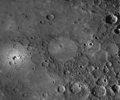File:Copland crater.png
Appearance

Size of this preview: 723 × 600 pixels. Other resolutions: 290 × 240 pixels | 579 × 480 pixels | 926 × 768 pixels | 1,235 × 1,024 pixels | 2,272 × 1,884 pixels.
Original file (2,272 × 1,884 pixels, file size: 2.5 MB, MIME type: image/png)
File history
Click on a date/time to view the file as it appeared at that time.
| Date/Time | Thumbnail | Dimensions | User | Comment | |
|---|---|---|---|---|---|
| current | 18:40, 17 December 2010 |  | 2,272 × 1,884 (2.5 MB) | LobStoR | reduced palette from 24-bit RGB to 8-bit greyscale |
| 07:44, 30 April 2010 |  | 2,272 × 1,884 (4.6 MB) | Bryan Derksen | {{Information |Description={{en|1=Instrument: Narrow Angle Camera (NAC) of the Mercury Dual Imaging System (MDIS) Scale: Copland crater has a diameter of 208 kilometers (129 miles) Projection: This image is a portion of the NAC approach mosaic from Mercur |
File usage
The following page uses this file:
Global file usage
The following other wikis use this file:
- Usage on ca.wikipedia.org
- Usage on en.wikipedia.org
- Usage on es.wikipedia.org
- Usage on fr.wikipedia.org
- Usage on it.wikipedia.org
- Usage on www.wikidata.org
- Usage on zh.wikipedia.org


